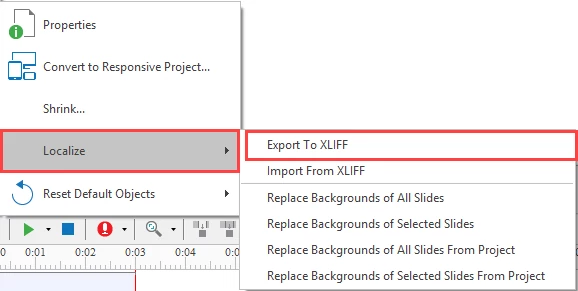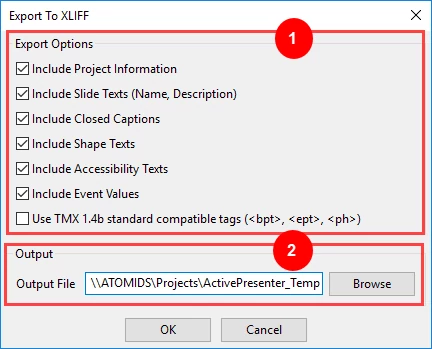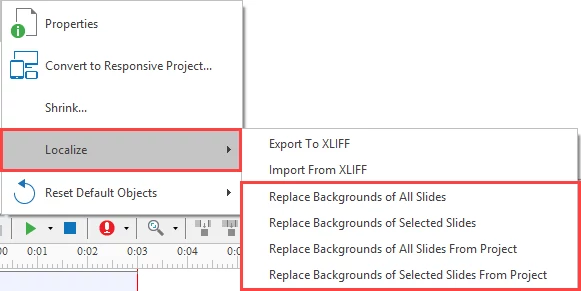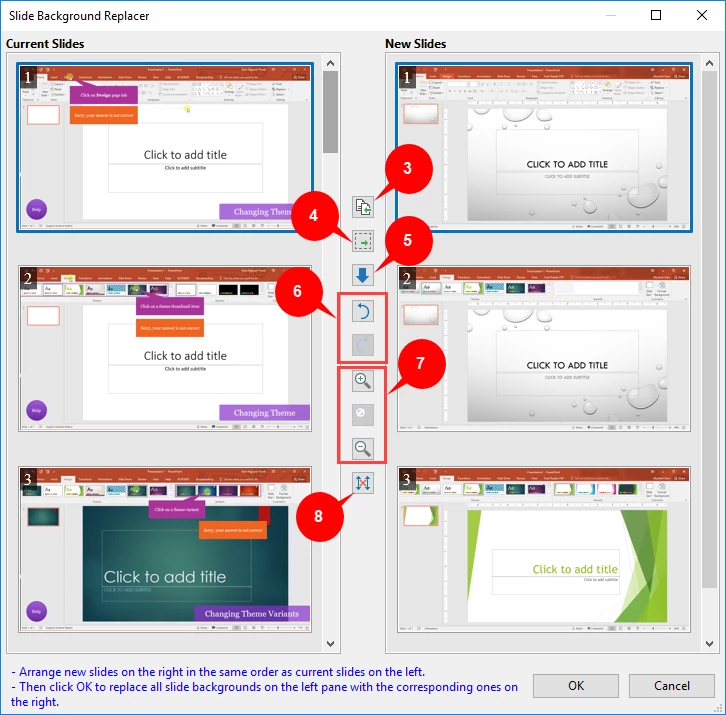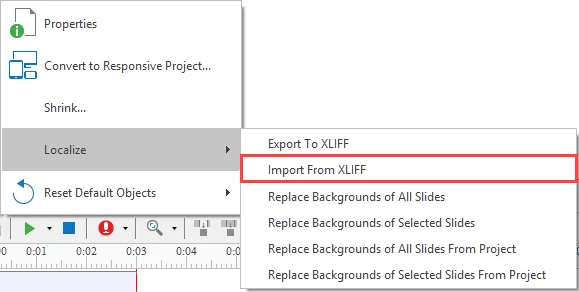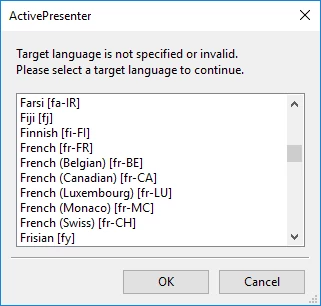Localization is the process of adapting a project for use in a specific country, a region with a particular language, culture, and desired local look and feel. If you are creating demonstrations or simulations of a certain application that supports multiple languages, you may need to localize projects for each language. With ActivePresenter, you can do it easily thanks to the slide background replacement and the text translation feature.
In general, the localizing process has three big steps. In each step, I’ll describe in more details with smaller steps for more clarification.
- Export text from projects to XLIFF format.
- Replace slide backgrounds.
- Import from XLIFF.
Before getting started to localize projects, make sure that you have finished editing the original project.
1. Export Text from Projects to XLIFF Format
XLIFF (XML Localization Interchange File Format) is an XML-based format created to standardize the way localizable data are passed between tools during a localization process.
To export text in your project to XLIFF format, do the following steps:
Step 1: Click the ActivePresenter button, select Project.
Step 2: Click Localize and then select Export to XLIFF from the context menu.
This opens the Export to XLIFF dialog as below.
Step 3: Select types of text that you want to export for the translation in the Export Options section (1).
Select Use TMX 1.4b standard compatible tags (<bpt>, <ept>, <ph>) if your translation tool doesn’t support <g> and <x/> tag.
Step 4: Enter the output location and file name in the Output File box (2) and then click OK to start exporting to XLIFF.
2. Replace Slide Backgrounds
Bear in mind that you should not localize directly in your original project, but in a copied version of the project. Keep reading to know how to copy projects and then replace slides.
Step 1: Create a copy of the original project for the new language.
- Copy the project file in File Explorer, or click the ActivePresenter button and then click Save As….
Note: If you copy it in File Explorer, make sure it is not opening in ActivePresenter. The project copied from an opening project may be corrupted.
- Give the copied project a meaningful name. It is recommended that the project name has language code suffice, for example, PowerPoint_es.approj. Besides, you can also create a folder for the new language and place the copied project there.
Step 2: Capture a new project for the new language.
- Change language preferences and settings for the captured application to display the new language if needed.
- Use the same project size (width x height) as the size of the original project.
- Name the new captured project a meaningful name and save it. For example, you can name it PowerPoint_es_captured.approj.
To know more about how to capture new projects, see Creating Software Simulations and Creating Video Demonstrations.
Step 3: Open the Slide Background Replacer window to replace slide backgrounds in the project copied in step 1 by new ones captured in step 2, or by slides of the new captured project. To do that:
- Open the project copied in step 1 (PowerPoint_es.approj).
- Click the ActivePresenter button, select Project and then click Localize.
Then, you can do one of the four following ways:
- Select Replace Backgrounds of All Slides to replace all slides backgrounds with slides of the new captured project. Selecting this option will launch the blue rectangle and the Replace Slide Backgrounds dialog. After that, start to capture a new project as normal.
- Select Replace Backgrounds of Selected Slides to replace some selected slide backgrounds with slides of the new captured project. Selecting this option will also launch the blue rectangle and the Replace Slide Backgrounds dialog. Then, you can capture a new project as normal.
- Select Replace Backgrounds of All Slides From Project and browse the new project captured in step 2 (PowerPoint_es_captured.approj) to replace all slide backgrounds of the current project.
- Select Replace Backgrounds of Selected Slides From Project and browse the new project captured in step 2 (PowerPoint_es_captured.approj) to replace some selected slide backgrounds of the current project.
Regardless the way you select, ActivePresenter will launch the Slide Background Replacer window, keep reading to know how to work with it.
Step 4: In the Slide Background Replacer window, arrange new slides on the right in the same order as on the left.
To move a slide, drag and drop it to the new position.
- To delete a slide, select it and press the DELETE key. You can also right-click it and select Delete from the context menu. Besides, you are free to copy and paste slides in this dialog.
Note: You cannot delete slides of the copied projects through this dialog. You have to delete them directly in the project.
- If you are not sure that a new slide of the new project (on the right) is redundant or not, move it to the bottom instead of deleting it. To do that, select the slide and click the down arrow button (5).
- If a certain slide is required in the new language but not available in the original language, select it and click Copy To Left (3). This moves the selected slide from the right to the left.
- If you do not want to change a certain slide on the left (e.g. the introduction slide), just select it and click Insert PlaceHolder (4). This inserts a placeholder slide into the right.
- Along with pressing CTRL+Z, you can use Undo and Redo button (6) to undo or redo actions.
- Use three command buttons (7) to zoom in/out/fit the slides.
- In order to scroll the slides on the left and on the right separately, click the Disable/Enable Synchronous Scrolling (8).
Step 5: Finally, click OK to replace slide backgrounds.
3. Import from XLIFF
After translating text and replacing slide backgrounds, you need to import the XLIFF file back to the project of which slide backgrounds are replaced. ActivePresenter will replace the current text in your project with the corresponding text in the translated XLIFF file.
Follow steps below to do that:
Step 1: Open the project that has been replaced slide backgrounds.
Step 2: Click the ActivePresenter button and select Project.
Step 3: Click Localize and then select Import From XLIFF.
Step 4: Browse the translated XLIFF file and then select the new language, and click OK.
Step 5: Verify imported text on each slide, after that, adjust the object position and size if necessary
That’s how to localize projects in ActivePresenter 7. Try it and feel free to contact us if you need help.
